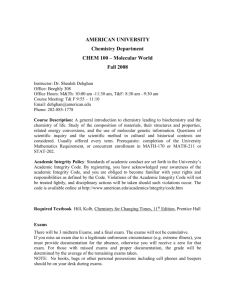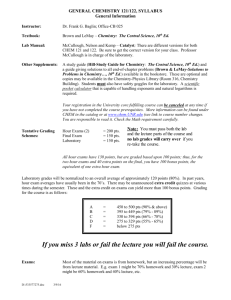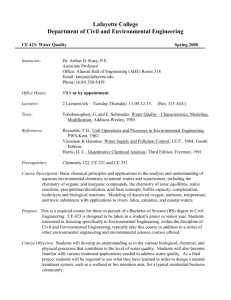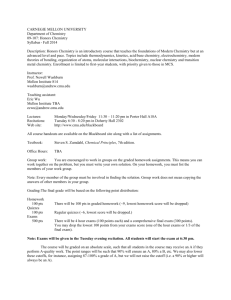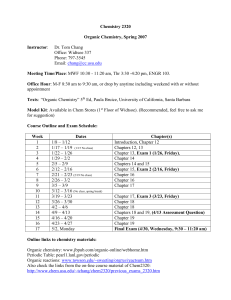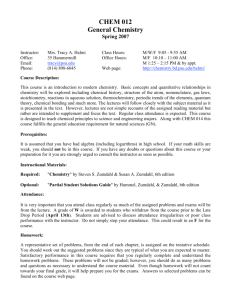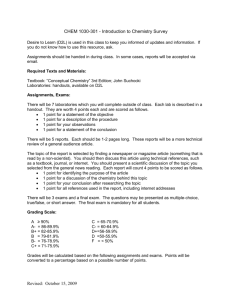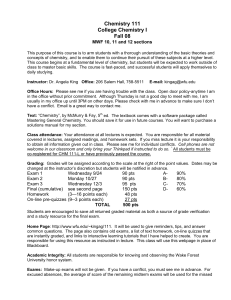CHEM 101, FALL 1999 - University of Nevada, Reno
advertisement
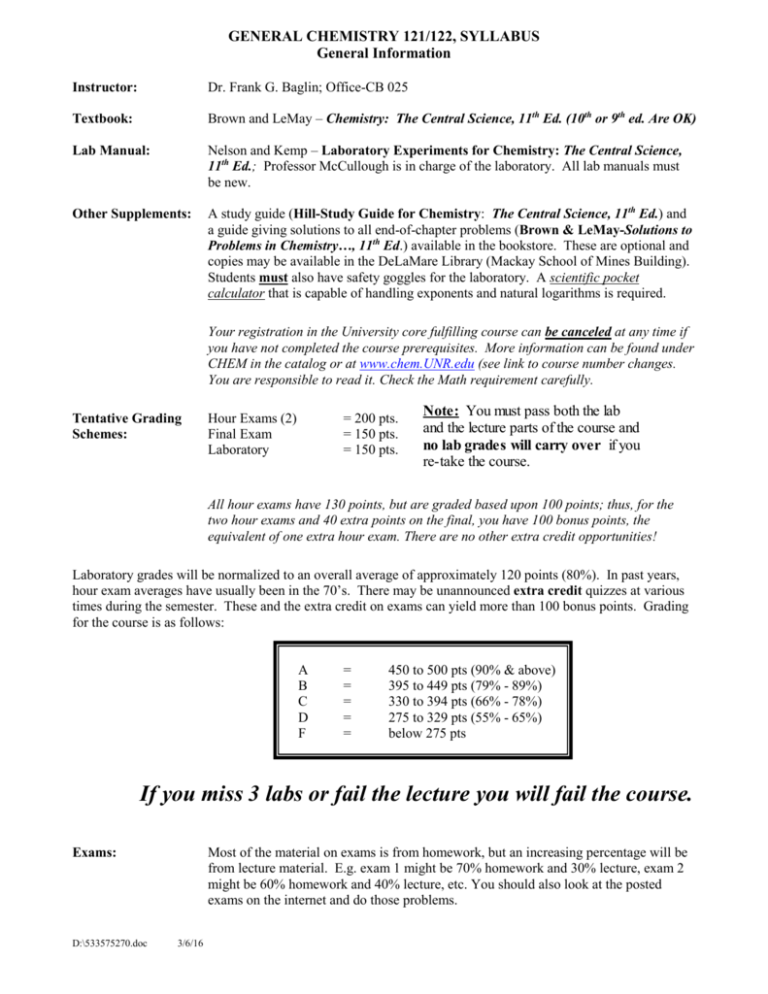
GENERAL CHEMISTRY 121/122, SYLLABUS General Information Instructor: Dr. Frank G. Baglin; Office-CB 025 Textbook: Brown and LeMay – Chemistry: The Central Science, 11th Ed. (10th or 9th ed. Are OK) Lab Manual: Nelson and Kemp – Laboratory Experiments for Chemistry: The Central Science, 11th Ed.; Professor McCullough is in charge of the laboratory. All lab manuals must be new. Other Supplements: A study guide (Hill-Study Guide for Chemistry: The Central Science, 11th Ed.) and a guide giving solutions to all end-of-chapter problems (Brown & LeMay-Solutions to Problems in Chemistry…, 11th Ed.) available in the bookstore. These are optional and copies may be available in the DeLaMare Library (Mackay School of Mines Building). Students must also have safety goggles for the laboratory. A scientific pocket calculator that is capable of handling exponents and natural logarithms is required. Your registration in the University core fulfilling course can be canceled at any time if you have not completed the course prerequisites. More information can be found under CHEM in the catalog or at www.chem.UNR.edu (see link to course number changes. You are responsible to read it. Check the Math requirement carefully. Tentative Grading Schemes: Hour Exams (2) Final Exam Laboratory = 200 pts. = 150 pts. = 150 pts. Note: You must pass both the lab and the lecture parts of the course and no lab grades will carry over if you re-take the course. All hour exams have 130 points, but are graded based upon 100 points; thus, for the two hour exams and 40 extra points on the final, you have 100 bonus points, the equivalent of one extra hour exam. There are no other extra credit opportunities! Laboratory grades will be normalized to an overall average of approximately 120 points (80%). In past years, hour exam averages have usually been in the 70’s. There may be unannounced extra credit quizzes at various times during the semester. These and the extra credit on exams can yield more than 100 bonus points. Grading for the course is as follows: A B C D F = = = = = 450 to 500 pts (90% & above) 395 to 449 pts (79% - 89%) 330 to 394 pts (66% - 78%) 275 to 329 pts (55% - 65%) below 275 pts If you miss 3 labs or fail the lecture you will fail the course. Exams: D:\533575270.doc Most of the material on exams is from homework, but an increasing percentage will be from lecture material. E.g. exam 1 might be 70% homework and 30% lecture, exam 2 might be 60% homework and 40% lecture, etc. You should also look at the posted exams on the internet and do those problems. 3/6/16 NOTE: This class is not graded on a curve Make-Up Exams: Make-Up exams will not be given. If an hour exam is missed and there is a valid excuse, the percentage grade on the final examination will be substituted for the missing grade. Notify me in advance if at all possible!!! (Email me at baglin@unr.edu .) Homework Assignments: Homework assignments are given below for each chapter. Homework will not be picked up, but it is vital for learning the material. Homework problems (or problems similar to them from the text) will make up most of the hour exams. Answers to homework problems are in the text supplement, Solutions to Problems in Chemistry: The Central Science, copies of which may be on reserve in the DeLaMare Library and for purchase in the Bookstore. You should work the problems at the end of each chapter. A tentative lecture outline is attached. Every exam will contain questions from the lecture. Laboratory Schedule: Will be handed out in the lab. There will NOT be labs the first week of school. YOU MUST ATTEND THE FIRST LAB PERIOD OR YOU WILL LIKELY LOSE YOUR REGISTRATION. The first lab will be held in the SECOND week of school. Wait Listing for or Dropping of Courses: NOTES: Check with the Registrar in Student Services or the computer registration system. (a) If you checked into class late, be sure to have read this document carefully and understand it. Remember, THIS IS YOUR GRADE!!! Any questions, see me after class and I’ll be glad to clarify things. (b) If you are working and taking three or more other solid academic courses, you should not work more than 20 hours/week. Working and/or work schedules are not a reason for special treatment, grade-wise. Please read the results (below) of a Nevada campus survey. “Our students report more outside work (77% work, 56% work 20 or more hours per week) and less financial assistance (55% report no assistance from their family) than students in similar institutions. In the alumni survey, 90% worked at some time while attending the University. Nationally at similar institutions, the norm indicates only 59% of students work at all, and the rate of “no assistance from their family” is 27%. Our undergraduate students are clearly different than those at most public research institutions—they work more and receive less help from their families. The primary reason for withdrawing from the University is work conflict and time management. (c) I expect every student to keep up on the reading assignments and to ask questions about topics or homework that they find confusing. There should be an interactive exchange between instructor and class. Work is not an excuse for failure to complete assignments or to be present for exams (nor is the beginning of deer season!). Moreever, there will be Q and A throughout the semester…be prepared. (d) This is a tentative schedule which may well be revised during the semester; you are responsible to be present for exams and quizzes at the correct time and place. Safety in the lab—General Chemistry lab safety is largely composed of common sense; e.g., boiling H2O and its container are hot and will burn you as will freshly bent glass. There is a safety manual on reserve in the Physical Sciences Library, “Safety in Academic Chemistry Laboratories,” and there is a section on the Chemistry Department web page as well. No “flip-flops” or other open toed shoes are permitted and long pants are strongly advised. Safety glasses are mandatory as well. There is a safety quiz that you must take online and turn into your lab instructor. D:\533575270.doc 3/6/16
